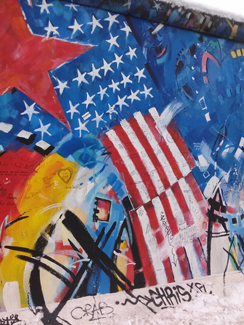Product Description
Barry L. Thumma, Face of America, Gelatin silver print 1980


BARRY L. THUMMA (1947-2003) USA
Face of America 1980
Gelatin silver print
Size: H: 13 3/8” x W: 11”
Size (with board): H: 14” x W: 11”
Size (framed): H: 21 ¼” x W: 17”
Price: $2,750
Barry L. Thumma, a former New Era photographer, covered four presidents as White House photographer for The Associated Press. In his 20-year career with the AP, he traveled on more than 100 Air Force One flights to photograph presidents Jimmy Carter, Ronald Reagan, George H.W. Bush and Bill Clinton. He also photographed Pope John Paul II, Jerry Falwell, Mikhail Gorbachev, Michael Deaver, Alan Greenspan and Donald Rumsfeld, among other personalities and politicians of his time. He was a member of the White House News Photographers Association. Thumma began his career in 1967 as a part-time photographer for the Lancaster New Era. He joined the Associated Press in 1973 in Cincinnati, where he covered the Reds and the Bengals. After two years as the Ohio photo editor, Thumma moved to Washington, D.C. to cover the White House. He also captured heartbreaking images of the famine in Ethiopia, NASA space flight operations and troop actions in the field.
Barry L. Thumma, Face of America, Gelatin silver print 1980
JEFF LOUVIERE (b.1971) USA
VANESSA S. BROWN (b.1970) USA
Chlorofemina, Neque (from “As if…”) 2005
Mixed media, pigment print, wax mixed with pigment
Edition: 2/5 (printed in 2008)
Signed: Louviere and Vanessa
Image H: 53” x W: 45”
Price: $35,000
“By collaborating, we put ourselves in the midst of alternating currents of decision and production, action and responsibility, decay and clarity-capturing the moment between ‘has been ‘ and ‘what will be.'”
Jeff Louviere has a background in graphic design and art direction, winning several national and international awards. Vanessa S. Brown was 12 when she made her first photographs, and was exhibiting at 17. Her work gained international acclaim even before she earned her BFA from Rochester Institute of Technology. Louviere received his MFA from Savannah College of Art and Design, and it was in Savannah, Georgia that Jeff and Vanessa met. Their first collaboration was a series of photo storyboards for a film they had written together. The two moved to New Orleans in 1998 and have been exhibiting nationally ever since.
Jeff Louviere and Vanessa Brown have been collaborating on photographic images and movies since they first met in the mid-90s. Under the moniker Louviere+Vanessa they have created moody, atmospheric visuals with various equipment, including scanners, 8mm film, destroyed negatives, wax and even blood, utilizing the Holga medium format camera, altering the negatives and creating assemblages
ROSE CABAT (1914-2015) USA
Rare and important large scale “Feelie” c. 1980-85
Thin walled porcelain vessel with a silky satiny matte drip glaze
Signed: incised CABAT on bottom
For more information on Rose Cabat see: Rose Erni Cabat Retrospective 1936-1986 (Tuscon, AZ: Tuscon Museum of Art, 1986)
H: 3 5/8″
Price: $1,650
Rose Cabat was an American studio ceramicist living in Tucson. Considered one of the most important ceramic artists of the Mid-century Modernist movement, Cabat is best known for her innovative glazes on small porcelain pots called “feelies” which she developed in the 1960s. Her organic forms often resemble the shape of onions and figs, and her glazes range from organic to jewel tones. Cabat was born in 1914 in the Bronx, New York, began to work in ceramics in the late 1930′s, and moved to Arizona in 1942, where she continued to make innovative ceramics.
Feelies:
Feelies are described as onion, fig, cucumber, and saucer-shaped ceramic vases terminating in an upward closed neck. Bruce Block, an avid collector, has described them as sensual and tactile with a very specific unforgettable texture, spiritual seeming to contain a type of energy. Rose Cabat had developed a silky satiny glaze, and it wasn’t until around 1960 that she had hit upon the first of the appropriate form, svelte and sleek to match the glaze. She exclaimed, “Now this one’s a feelie.”, coining the term. Upon developing the new glazes, she felt that she needed new forms to apply the glazes to, different from what she made before, “craft fair” style coiled heads and wind bells. She is quoted as saying, “The old things did not look good … I wanted simpler shapes that went with the glazes.”They are typically globular in shape, tightening down to a minuscule neck glazed to a satin surface. The tactile experience is most important. The nature of the neck is such that it is closed, so narrow that it cannot hold anything. Cabat would reply when asked why the necks of her feelies are so narrow, “A vase can hold weeds or flowers, but can’t it just be a spot of beauty?”
